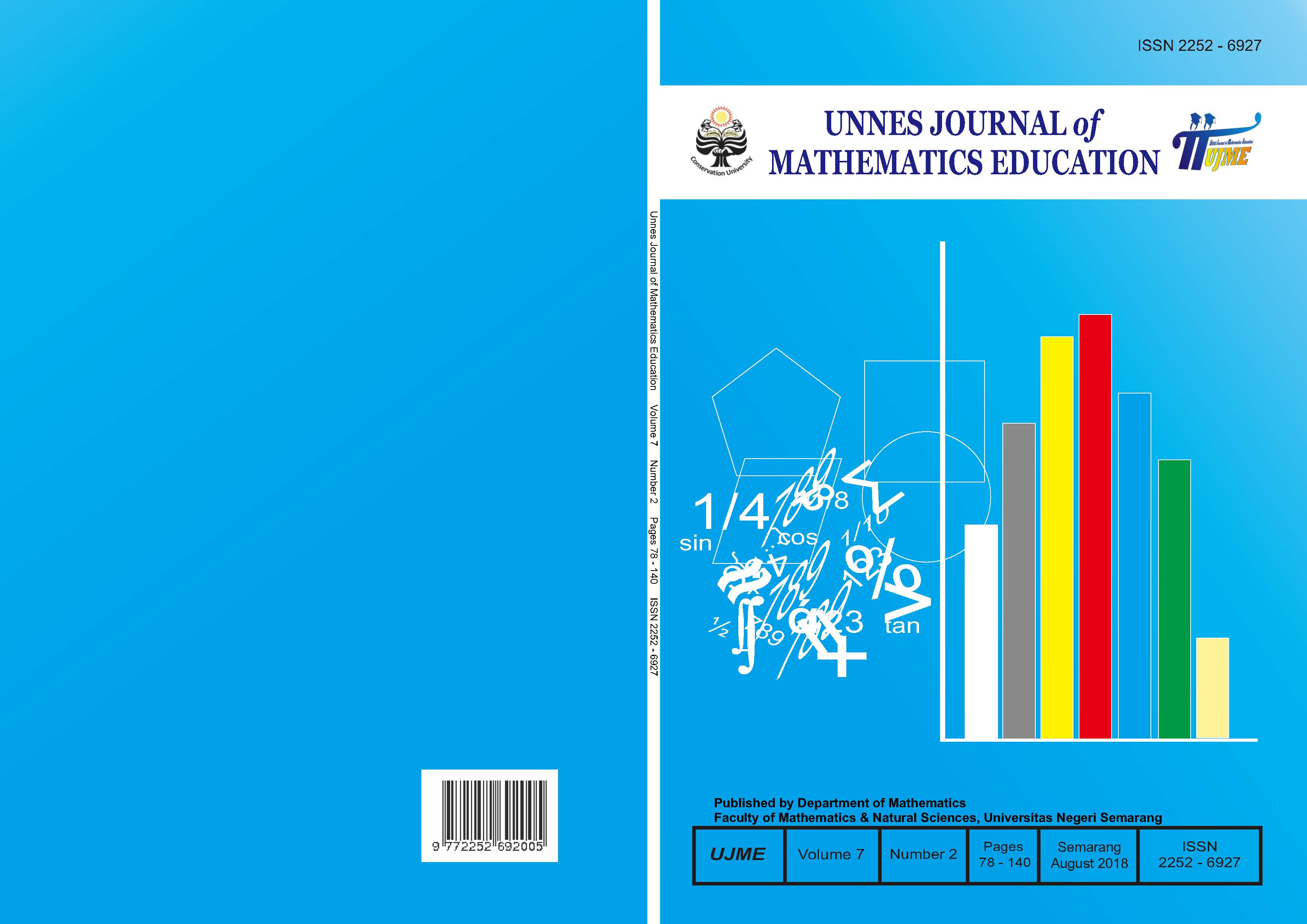The mathematical communication ability based on gender difference on students of 11th grade by using problem-based learning model assisted by probing prompting technique
##plugins.themes.academic_pro.article.main##
Abstract
This study aims to test the MCA (Mathematical Communication Ability) in Problem Based Learning (PBL) model assisted Probing Prompting Technique (PBL PP), to achieve learning mastery, to know the average ratio of MCA of students on learning model of PBL PP and PBL only, to differ the MCA of male students with female students in PBL PP, and to describe MCA of students based on gender difference. The method used in this research is mix method. While the population is science program students of XI grade at MAN 2 Semarang. The sample is chosen with random sampling. In addition, students of XI IPA 1 are as experiment class, while students of XI IPA 2 as control class. The qualitative research subjects in this study are six students, for each is taken three from every male and female students in experiment class. The results of this research are the MCA’s students with PBL PP learning reaches the learning mastery, the average ratio of MCA in PBL PP is better than PBL model, the MCA of male and female students have no significant difference, and there are some differences of MCA in each indicators based on gender difference.
##plugins.themes.academic_pro.article.details##
References
Amir, Z. (2013). Perspektif gender dalam pembelajaran matematika. Marwah: Jurnal Perempuan, Agama Dan Jender, 12(1), 15-31.
Anintya, Y. A., Pujiastuti, E., & Mashuri. (2017). Analisis Kemampuan Komunikasi Matematis Ditinjau dari Gaya Belajar Siswa Kelas VIII pada Model Pembelajaran Resource Based Learning. Unnes Journal of Mathematics Education, 6(1): 37-43.
Asikin, M. & Junaedi, I. (2013). Kemampuan Komunikasi Matematika Siswa SMP dalam Setting Pembelajaran RME (Realistic Mathematics Education). Unnes Journal of Mathematics Education Research, 2(1), 203-213.
Githua, B. N. & Mwangi, J.G. (2003). Students’ Mathematics Self-concept and Motivation to Learn Mathematics: Relationship and Gender Differences among Kenya’s Secondary-school Students in Nairobi and Rift Valley Provinces. International Journal of Educational Development, 23(5), 487-499.
Glasser, H.M. & Smith J.P. (2008). On the Vague Meaning of “Gender†in Education Research: The Problem, Its Sources, and Recommendations for Practice. Educational Researcher, 37(6), 343-350.
Larsson, J. A. (2007). Communication of Mathematics as a Tool to Improve Student’s General of Communicative Skills. In Proceedings of the 3rd International CDIO Conference. MIT, Cambridge, USA.
Lomibao, L. S., Luna, C. A., & Namoco R. A. (2016). The Influence of Mathematical Communication on Student’s Mathematics Performance and Anxiety. American Journal of Educational Research, 4(5), 378-382.
Murniati, S., Mulyono, & Kharis, M. (2017). Pembelajaran PBL Strategi Working Backward untuk Meningkatkan Kemampuan Pemecahan Masalah Matematik Siswa. Unnes Journal of Mathematics Education, 6(1), 27-36.
NCTM. (2000). Principles and Standards for School Mathematics. USA: Reston Virginia, Inc.
Prasetyo, A., Dwidayati, N. K., & Junaedi, I. (2017). Students’s Mathematical Connection Ability and Disposition Reviewed by Keirsey Personality Type through Eliciting Activities Mathematics Learning Model. Unnes Journal of Mathematics Education, 6(2), 190-197.
Putri, L., Dwijanto, & Sugiman. (2017). Keefektifan Pembelajaran SAVI pada Pencapaian Kemampuan Komunikasi dan Disposisi Matematis Siswa Kelas VIII. Unnes Journal of Mathematics Education, 6(1), 97-107.
Ramdani, Y. (2012). Pengembangan Instrumen dan Bahan Ajar untuk Meningkatkan Kemampuan Komunikasi, Penalaran, dan Koneksi Matematis dalam Konsep Integral. Jurnal Penelitian Pendidikan, 13(1), 44-52.
Sefiany, M., Masrukan, & Zaenuri. (2016). Kemampuan Komunikasi Matematis Siswa Kelas VII pada Pembelajaran Matematika dengan Model Knisley Berdasarkan Self Efficacy. Unnes Journal of Mathematics Education, 5(3), 227-233.
Siregar, N. H. & Fauzi. M. A., (2016). The Difference between Mathematical Reasoning Ability Improvement by Learning with Meta Cognitive Approach Aided Probing and Prompting Techniques in SMP Negeri 4 SeiSuka. World Journal of Educational Research, 4(1), 120-137.
Sufi, L. F. (2016). Meningkatkan Kemampuan Komunikasi Matematis Siswa Melalui Model Pembelajaran Problem Based Learning. Prosiding1st Konferensi Nasional Penelitian Matematika dan Pembelajarannya. Solo: Universitas Muhammadiyah Surakarta.
Sugiyono. (2011). Metode Penelitian Kombinasi (Mixed Methods). Bandung: Penerbit Alfabeta.
Triyadi, R. (2013). Kemampuan matematis ditinjau dari perbedaan gender (Doctoral dissertation, Universitas Pendidikan Indonesia).
